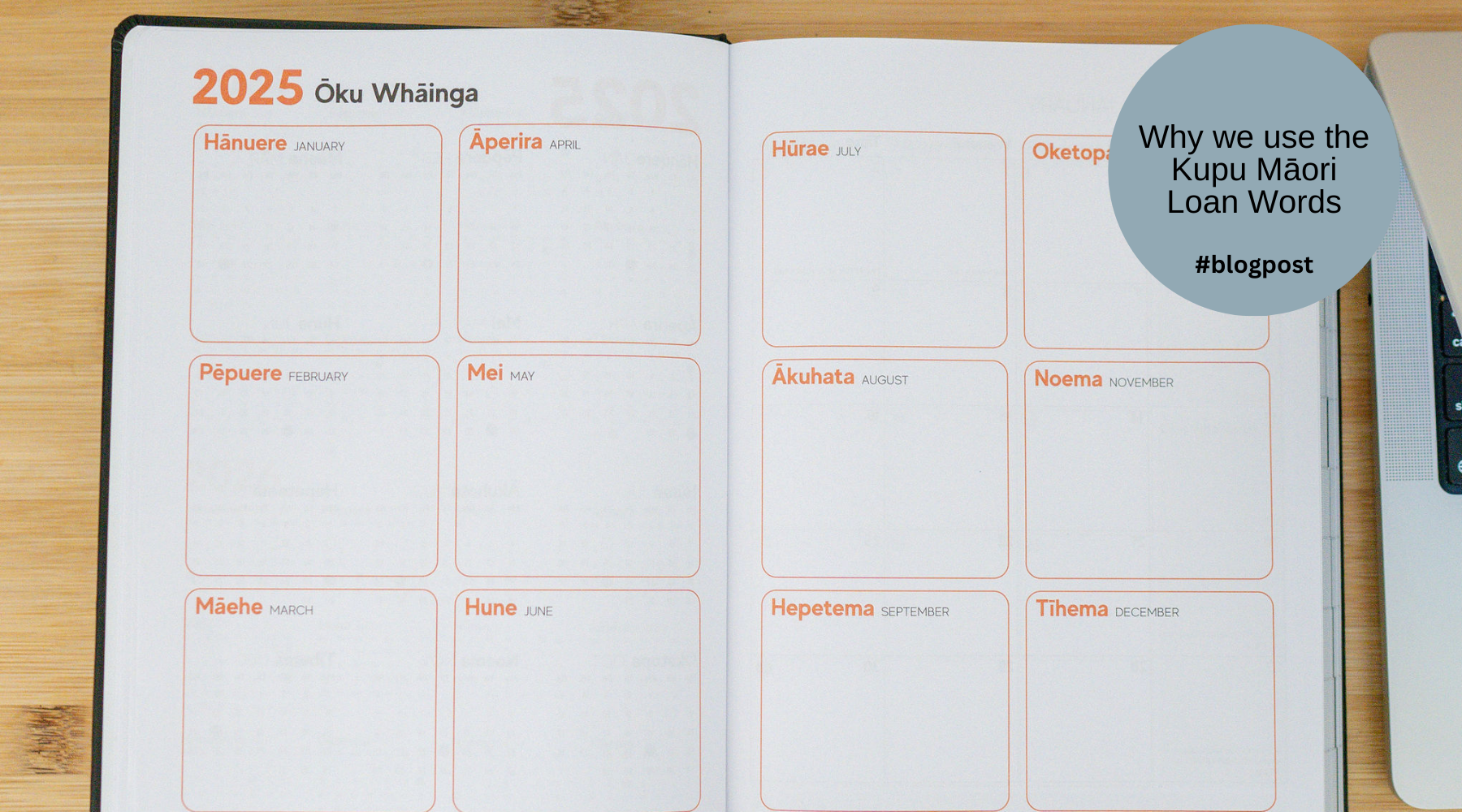If you have bought any of our stationery you will note that we use the “loan Māori / transliterated words” for days of the week and months of the year.
In 2019, we attended some of Professor Rangi Matamua (Tuhoe)[1] lectures that he held around the motu for his “Matariki series[2]”. Amongst the wealth of information he shared, was a challenge for people to distinguish the Western methods of measuring time (based on the solar Gregorian calendar) and the Māori methods of measuring time – which were influenced by a range of measures – including the stellar, lunar and tidal calendars.
His challenge was that - if its Gregorian calendar based, then use the transliteration of those days/ months - as our kupu does not match up with their calendar, or the reasons for the names of the days/ months. His korero made perfect sense to us, and since 2019 we have switched.
In our diaries & planners, we use the loan words for days of the week, and months of the year – to distinguish the Gregorian calendar. On each month, we mark when Whiro (New Moon) or Te Rakaunui (Full Moon) rises – so that whichever maramataka you are using, you can anchor yourself to one of those starting points - and can follow the 30 nights (not 7 day week cycles of the Gregorian calendar). Then, on Whiro of each month, we include the name of the Māori month (as the Māori months start on the New Moon, not on the 1st of the month) and then at the bottom of each calendar spread – we provide the quotes from Tuhoe in reference to each marama, quoted within Elsdon Bests 1922 book “Māori division of time” in the chapter about “Māori months”.
So this year June 2021 - we call it Hune, and on the 10th June when Whiro rises, the month of Pipiri begins - not on the 1st of the month, so we do not have the word Pipiri at the top of our calendar layout - because it does not translate to June, Pipiri is shown on the New Moon date, and the korero behind the kupu is within the quote at the bottom of our calendar layout, and in reference to the stars. Does that make sense? Gosh we hope so!
See blog cover image
We get a lot of feedback on our use of Loan Words, and want to share that they are not there by mistake, we have intentionally used them to hopefully – respect but distinguish between Western & Māori measures of time.
If you’re still reading at this point – then we also thought we would share some more information about where the days of the week and months have actually come from. Thanks Google!
Days of the Week
Modern Latin-based cultures, in general, directly inherited the days of the week from the Romans and they were named after the classical planets[3]
The modern English days of the week were inherited from gods of the old Germanic Norse culture — Wednesday is Wōden’s-day (Wōden or Wettin eqv. Mercury), Thursday is Thor’s-day (Thor eqv. Jupiter), Friday is Frige-day (Frig eqv. Venus).
|
Weekday |
Planet |
Germanic god |
|
English name |
Roman god |
Saxon name |
|
Sunday |
Sunne |
|
|
Monday |
Mōnda |
|
|
Tuesday |
Tīw |
|
|
Wednesday |
Wōden / Wettin |
|
|
Thursday |
Thunor |
|
|
Friday |
Frige |
|
|
Saturday |
Saturn |
- |
From roughly the 1990s, these Māori words were promoted to use for the days of the week, that align to the korero of the English words;
|
English |
Māori |
Reference |
English translation |
|
Monday |
Rāhina |
day of the Moon |
rā + Māhina (day + Moon) |
|
Tuesday |
Rātū |
day of Mars |
rā + Tūmatauenga (day + Mars) |
|
Wednesday |
Rāapa |
day of Mercury |
rā + Apārangi (day + Mercury) |
|
Thursday |
Rāpare |
day of Jupiter |
rā + Pareārau (day + Jupiter) |
|
Friday |
Rāmere |
day of Venus |
rā + Mere (day + Venus) |
(Note - Rāhoroi = Saturday & Rātapu = Sunday were unchanged – were already often used)
If like us – you went to school before the 1990s, you are most likely more familiar with the transliterations or loan words of many English words – including the days of the week and months.
- Mane = Monday
- Tūrei = Tuesday
- Wenerei = Wednesday
- Tāite = Thursday
- Paraire = Friday
- Rāhoroi / Hāterei = Saturday
- Rātapu / Wiki = Sunday
We have chosen to use the loan words, as day names have a whakapapa to Roman times, not Māori. Traditionally most Māori followed the 30 nights of the Maramataka, not 7 days a week. Dr Rangi Matamua korero seemed very logical and practical to us - that we should go back to use these loan words for days/ months - and then know what night of the maramataka we are in, and what month following the stars – instead of trying to overlay Gregorian & Maori and mix the different korero.
Months of the Year
If you are still with us in this long blog – then similarly, how the months of the year got their names are shown below
|
Gregorian Month |
Latin Source |
Meaning |
|
January |
mēnsis Iānuārius, "Month of Janus |
the Roman god of gates, doorways, beginnings, and endings |
|
February |
mēnsis Februārius, "Month of the Februa" |
the Roman festival of purgation and purification, |
|
March |
mēnsis Mārtius, "Month of Mars", |
the Roman war god |
|
April |
mēnsis Aprīli |
of uncertain meaning but usually derived from some form of the verb aperire ("to open") or the name of the goddess Aphrodite |
|
May |
mēnsis Māius, "Month of Maia" |
a Roman vegetation goddess whose name is cognate with Latin magnus ("great") |
|
June |
mēnsis Iūnius, "Month of Juno", |
the Roman goddess of marriage, childbirth, |
|
July |
mēnsis Iūlius, "Month of Julius Caesar" |
the month of Caesar's birth, instituted in 44 bc as part of his calendrical reforms |
|
August |
mēnsis Augustus, "Month of Augustus |
instituted by Augustus in 8 bc in agreement with July and from the occurrence during the month of several important events during his rise to power |
|
September |
mēnsis september, |
"seventh month" of the ten-month Roman year of Romulus c. 750 bc |
|
October |
mēnsis octōber |
"eighth month" of the ten-month Roman year of Romulus c. 750 bc |
|
November |
mēnsis november |
"ninth month", of the ten-month Roman year of Romulus c. 750 bc |
|
December |
mēnsis december |
"tenth month", of the ten-month Roman year of Romulus c. 750 bc |
We can then look at the Gregorian Calendar months, the loan words given, and compare with the Māori months, knowing their order and when they commence.
|
Gregorian Month |
Gregorian Month |
Māori Transliteration / Loan Word |
Māori month |
Māori month starting on Whiro (New Moon) |
|
1 |
January |
Hānuere |
8 |
Kohitātea |
|
2 |
February |
Pēpuere |
9 |
Huitanguru |
|
3 |
March |
Māehe |
10 |
Poutūterangi |
|
4 |
April |
Āperira |
11 |
Paengawhāwhā |
|
5 |
May |
Mei |
12 |
Haratua |
|
6 |
June |
Hune |
1 |
Pipiri |
|
7 |
July |
Hūrae |
2 |
Hōngongoi |
|
8 |
August |
Ākuhata |
3 |
Hereturikōkā |
|
9 |
September |
Hepetema |
4 |
Mahuru |
|
10 |
October |
Oketopa |
5 |
Whiringa-ā-nuku |
|
11 |
November |
Noema |
6 |
Whiringa-ā-rangi |
|
12 |
December |
Tihema |
7 |
Hakihea |
Note – there are also dialectal differences in the Māori months and for some iwi an additional month added – a great example to see those different kupu is in the Tainui Te Reo Dictionary
Korero Whakamutunga
This is a long blog post we know - you did great to get to this point!
But hopefully it explains a little as to why we have set out our resources like we have. We acknowledge Dr Rangi Matamua, and the pioneering work he does in sharing this knowledge, and we hopefully have stepped into the challenges he lays and found a way to incorporate Māori measures of time, while still living in our Western world – in the resources we create.
We are not academics, but stationery geeks who love to learn and share mātauranga Māori to improve our daily lives and help us reconnect back to traditional practices. If we get it wrong a long the way, mō tō māua hē, we are still learning and trying, so we appreciate all the feedback we get.
Ngā mihi o te tau hou Māori,
Mānawatia a Matariki!
[1] Associate Dean Postgraduate within the Faculty of Māori and Indigenous Studies at the University of Waikato
[2] Ko Matariki e ārau ana | The gathering of Matariki series of talks
[3] https://en.wikipedia.org/wiki/Names_of_the_days_of_the_week


7 comments
Renée Gilmour
Love this, thank you for sharing your wisdom 🌹🍃💖
Melinda
Great blog post! I feel more confident in understanding the different calendars and names now. Thank you!
Maxine
Tēnā rawa atu.
Kerrie Bowen
Hello there, do you have a physical shop or other stockists where I can view your diaries?
Many thanks.
Kerrie
Maria
Kia ora for this post. I wondered that, and it makes absolute sense. I’ll be referring to this post in future, for sure. Tino pai, love love LOVE your stationery.
Maria
Jessica Powers
Love this – as I’ve wondered about the names a lot. To me the older loan names for the days sound more westernized, which you explain well. I mean, that still links them to the Roman deities doesn’t it? For the months, since it’s a solar based calendar, it makes sense to go with the loan words of the months and add in the Whiro and Te Rakanui so that the diary can have the moon based flow depending on how different folks work with it. I know my daughter is learning the days of the week as determined in the 1990s (thanks for that, being an import myself, I really appreciate the background information) and I wonder how that will change and alter as she moves through… As ever, thank you so much for helping fill in my understanding!
Terri Hughes
Rawe tōu kōrero e te tuahine! Miharo!